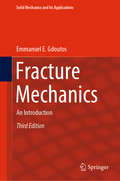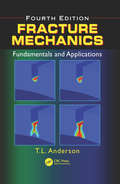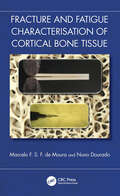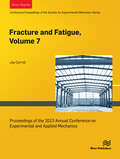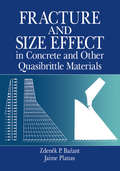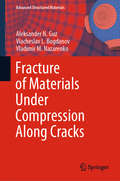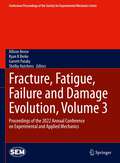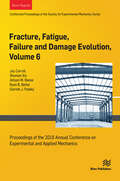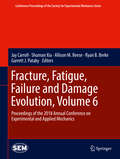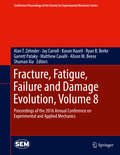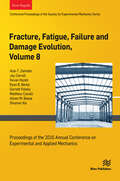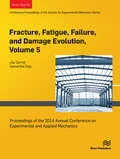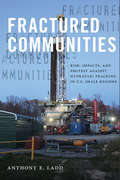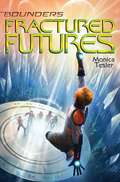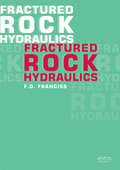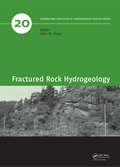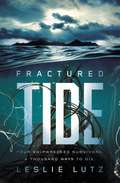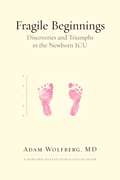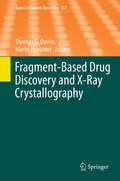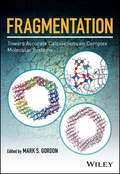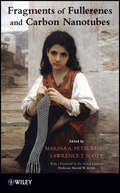- Table View
- List View
Fracture Mechanics: An Introduction (Solid Mechanics and Its Applications #263)
by Emmanuel E. GdoutosThis book discusses the basic principles and traditional applications of fracture mechanics, as well as the cutting-edge research in the field over the last three decades in current topics like composites, thin films, nanoindentation, and cementitious materials.Experimental methods play a major role in the study of fracture mechanics problems and are used for the determination of the major fracture mechanics quantities such as stress intensity factors, crack tip opening displacements, strain energy release rates, crack paths, crack velocities in static and dynamic problems. These methods include electrical resistance strain gauges, photoelasticity, interferometry techniques, geometric and interferometry moiré, and the optical method of caustics.Furthermore, numerical methods are often used for the determination of fracture mechanics parameters. They include finite and boundary element methods, Green’s function and weight functions, boundary collocation, alternating methods, and integral transforms continuous dislocations.This third edition of the book covers the basic principles and traditional applications, as well as the latest developments of fracture mechanics. Featuring two new chapters and 30 more example problems, it presents a comprehensive overview of fracture mechanics, and includes numerous examples and unsolved problems. This book is suitable for teaching fracture mechanics courses at the undergraduate and graduate levels. A “solutions manual” is available for course instructors upon request.
Fracture Mechanics: Fundamentals and Applications, Fourth Edition
by Ted L. AndersonFracture Mechanics: Fundamentals and Applications, Fourth Edition is the most useful and comprehensive guide to fracture mechanics available. It has been adopted by more than 150 universities worldwide and used by thousands of engineers and researchers. This new edition reflects the latest research, industry practices, applications, and computational analysis and modeling. It encompasses theory and applications, linear and nonlinear fracture mechanics, solid mechanics, and materials science with a unified, balanced, and in-depth approach. Numerous chapter problems have been added or revised, and additional resources are available for those teaching college courses or training sessions. Dr. Anderson’s own website can be accessed at www.FractureMechanics.com.
Fracture and Fatigue Characterisation of Cortical Bone Tissue
by Marcelo F. de Moura Nuno DouradoFracture and Fatigue Characterisation of Cortical Bone Tissue is a key guide to bone fracture and fatigue, focusing on quasi-static and fatigue-fracture characterisation of cortical bone tissue. Discussing the fundamental aspects of fracture mechanics and fatigue, which are applicable to many orthotropic materials, this book examines novel, cutting-edge approaches to analyse and model bone fracture and fatigue.As the population ages across the globe, bone fracture and fatigue has become a fundamental part of mechanical and biomedical engineering research. Beginning with a thorough description of fracture mechanics and fatigue, the book describes non-linear fracture mechanics under quasi-static and fatigue analyses. It goes on to present a cohesive zone modelling method which is appropriate for mode I, mode II and mixed-mode I+II loading. Presenting the latest research, this book describes cutting-edge fracture tests, new methods for data reduction purposes and numerical models based on cohesive zone modelling. This book is key to aiding both students and professionals in applying fundamental theories and methods to cortical bone tissue.The book will be of interest to students and professionals working in mechanical engineering and biomedical engineering, including work on quasi-static fracture, fracture under fatigue loading, artificial bones and fracture mechanisms.
Fracture and Fatigue, Volume 7: Proceedings of the 2013 Annual Conference on Experimental and Applied Mechanics
by Jay CarrollFracture and Fatigue, Volume 7: Proceedings of the 2013 Annual Conference on Experimental and Applied Mechanics, the seventh volume of eight from the Conference, brings together contributions to this important area of research and engineering. The collection presents early findings and case studies on a wide range of areas, including: Microstructural Effects in Fatigue & Fracture Fracture of Interfaces Fracture of Composites and Interface Cracks Fatigue & Fracture: Environmental & Loading Effects Fracture & Digital Image Correlation.
Fracture and Size Effect in Concrete and Other Quasibrittle Materials (New Directions In Civil Engineering Ser. #16)
by Zdenek P. Bazant Jaime PlanasFracture and Size Effect in Concrete and Other Quasibrittle Materials is the first in-depth text on the application of fracture mechanics to the analysis of failure in concrete structures. The book synthesizes a vast number of recent research results in the literature to provide a comprehensive treatment of the topic that does not give merely the facts - it provides true understanding. The many recent results on quasibrittle fracture and size effect, which were scattered throughout many periodicals, are compiled here in a single volume. This book presents a well-rounded discussion of the theory of size effect and scaling of failure loads in structures. The size effect, which is the most important practical manifestation of fracture behavior, has become a hot topic. It has gained prominence in current research on concrete and quasibrittle materials. The treatment of every subject in Fracture and Size Effect in Concrete and Other Quasibrittle Materials proceeds from simple to complex, from specialized to general, and is as concise as possible using the simplest level of mathematics necessary to treat the subject clearly and accurately. Whether you are an engineering student or a practicing engineer, this book provides you with a clear presentation, including full derivations and examples, from which you can gain real understanding of fracture and size effect in concrete and other quasibrittle materials.
Fracture of Materials Under Compression Along Cracks (Advanced Structured Materials #138)
by Aleksander N. Guz Viacheslav L. Bogdanov Vladimir M. NazarenkoThis book addresses the problems of fracture mechanics of materials with cracks under the loading directed along the cracks. It considers two non-classical fracture mechanisms, namely the fracture of bodies compressed along cracks and the fracture of materials with initial (residual) stresses acting in parallel to the surfaces of cracks location, and presents new approaches (also including combined one) developed in the framework of three-dimensional linearized mechanics of deformable bodies. It then discusses the results of studies on two- and three-dimensional problems for various configurations of crack locations in isotropic and anisotropic materials, and based on these results, critically evaluates the accuracy and applicability limits of the “beam approximation” approach, which is widely used to study various problems of the fracture of bodies under compression along parallel cracks.
Fracture, Fatigue, Failure and Damage Evolution, Volume 3: Proceedings of the 2022 Annual Conference on Experimental and Applied Mechanics (Conference Proceedings of the Society for Experimental Mechanics Series)
by Garrett Pataky Allison Beese Ryan B Berke Shelby HutchensFracture, Fatigue, Failure and Damage Evolution, Volume 3 of the Proceedings of the 2022 SEM Annual Conference & Exposition on Experimental and Applied Mechanics, the third volume of six from the Conference, brings together contributions to this important area of research and engineering. The collection presents early findings and case studies on a wide range of areas, including: Novel Experimental Methods Extreme Environments Interfacial Fracture Integration of Models & Experiments Mechanics of Energy & Energetic Materials Integration of Models & Experiments In Situ Techniques for Fatigue & Fracture Microscale & Microstructural Effects on Mechanical Behavior
Fracture, Fatigue, Failure and Damage Evolution, Volume 6: Proceedings of the 2018 Annual Conference on Experimental and Applied Mechanics
by Jay Carroll Allison M. Beese Shuman Xia Ryan B. Berke Garrett J. PatakyFracture, Fatigue, Failure and Damage Evolution, Volume 6 of the Proceedings of the 2018 SEM Annual Conference & Exposition on Experimental and Applied Mechanics, the sixth volume of eight from the Conference, brings together contributions to this important area of research and engineering. The collection presents early findings and case studies on a wide range of areas, including: Novel Experimental Methods Extreme Environments Interfacial Fracture Integration of Models & Experiments Mechanics of Energy & Energetic Materials Integration of Models & Experiments In Situ Techniques for Fatigue & Fracture Microscale & Microstructural Effects on Mechanical Behavior.
Fracture, Fatigue, Failure and Damage Evolution, Volume 6: Proceedings of the 2018 Annual Conference on Experimental and Applied Mechanics (Conference Proceedings of the Society for Experimental Mechanics Series)
by Jay Carroll Allison M. Beese Shuman Xia Ryan B. Berke Garrett J. PatakyFracture, Fatigue, Failure and Damage Evolution, Volume 6 of the Proceedings of the 2018 SEM Annual Conference & Exposition on Experimental and Applied Mechanics, the sixth volume of eight from the Conference, brings together contributions to this important area of research and engineering. The collection presents early findings and case studies on a wide range of areas, including:Novel Experimental Methods Extreme Environments Interfacial Fracture Integration of Models & Experiments Mechanics of Energy & Energetic Materials Integration of Models & Experiments In Situ Techniques for Fatigue & Fracture Microscale & Microstructural Effects on Mechanical Behavior
Fracture, Fatigue, Failure and Damage Evolution, Volume 7: Proceedings of the 2017 Annual Conference on Experimental and Applied Mechanics
by Jay Carroll Shuman Xia Ryan B. Berke Alison M. Beese Garrett J. PatakyFracture, Fatigue, Failure and Damage Evolution, Volume 7 of the Proceedings of the 2017 SEM Annual Conference & Exposition on Experimental and Applied Mechanics, the seventh volume of nine from the Conference, brings together contributions to this important area of research and engineering. Session organizers include: Jay Carroll, Shuman Xia, Allison Beese, Ryan Berke, Garrett Pataky, Samantha Daly, Kavan Hazeli, Antonios Kontsos, Omer Ozgur Capraz, Scott Grutzik, Onome Scott-Emaukpor The collection presents early findings and case studies on a wide range of areas, including: Mechanics of Energy & Energetic Materials Vibration Effects in Fracture & Fatigue Fracture & Fatigue of Additively Manufactured Materials In Situ Techniques for Fatigue & Fracture Microscale & Microstructural Effects on Mechanical Behavior Fracture & Fatigue of Composites Integration & Validation of Models with Experiments Fracture & Fatigue in Extreme Environments Novel Experimental Methods for Fatigue and Fracture Fracture of Brittle & Ductile Materials Interfacial Fracture.
Fracture, Fatigue, Failure and Damage Evolution, Volume 8
by Jay Carroll Alan T. Zehnder Shuman Xia Kavan Hazeli Ryan B. Berke Garrett Pataky Matthew Cavalli Alison M. BeeseFracture, Fatigue, Failure and Damage Evolution, Volume 8 of the Proceedings of the 2016 SEM Annual Conference & Exposition on Experimental and Applied Mechanics, the eighth volume of ten from the Conference, brings together contributions to this important area of research and engineering. The collection presents early findings and case studies on a wide range of areas, including: In-situ Techniques for Fracture & Fatigue General Topics in Fracture & Fatigue Fracture & Fatigue of Composites Damage, Fracture, Fatigue & Durability Interfacial Effects in Fracture & Fatigue Damage Detection in Fracture & Fatigue
Fracture, Fatigue, Failure and Damage Evolution, Volume 8: Proceedings of the 2016 Annual Conference on Experimental and Applied Mechanics
by Jay Carroll Alan T. Zehnder Shuman Xia Kavan Hazeli Ryan B. Berke Garrett Pataky Matthew Cavalli Alison M. BeeseFracture, Fatigue, Failure and Damage Evolution, Volume 8 of the Proceedings of the 2016 SEM Annual Conference & Exposition on Experimental and Applied Mechanics, the eighth volume of ten from the Conference, brings together contributions to this important area of research and engineering. The collection presents early findings and case studies on a wide range of areas, including: In-situ Techniques for Fracture & Fatigue General Topics in Fracture & Fatigue Fracture & Fatigue of Composites Damage, Fracture, Fatigue & Durability Interfacial Effects in Fracture & Fatigue Damage Detection in Fracture & Fatigue.
Fracture, Fatigue, Failure, and Damage Evolution, Volume 5: Proceedings of the 2014 Annual Conference on Experimental and Applied Mechanics
by Jay Carroll Samantha DalyFracture, Fatigue, Failure and Damage Evolution, Volume 5: Proceedings of the 2014 Annual Conference on Experimental and Applied Mechanics, the fifth volume of eight from the Conference, brings together contributions to this important area of research and engineering. The collection presents early findings and case studies on a wide range of areas, including: Mixed Mode Fracture I: Emphasis on Modeling Mixed Mode Fracture II: Emphasis on Experimental Measurements Full-Field Measurements of Fracture Microscale & Microstructural Effects on Mechanical Behavior I: Nanoscale Effects Microscale & Microstructural Effects on Mechanical Behavior II: MEMS Microscale & Microstructural Effects on Mechanical Behavior III: Microstructure Microscale & Microstructural Effects on Mechanical Behavior IV: Shape Memory Alloys Fracture & Fatigue of Composites Fracture & Fatigue for Engineering Applications Wave-Based Techniques in Fracture & Fatigue I Wave-Based Techniques in Fracture & Fatigue II: Acoustic Emissions.
Fractured Communities: Risk, Impacts, and Protest Against Hydraulic Fracking in U.S. Shale Regions (Nature, Society, and Culture)
by Peter Hall Stephanie A. Malin Suzanne Staggenborg Anthony E. Ladd Hilary Boudet Sherry Cable Brittany Gaustad James Maples Tamara Mix Carmel Price Dakota K.T. Raynes Stacia Ryder Trang Tran Ion Bogdan Vasi Cameron Thomas Whitley Patricia WidenerWhile environmental disputes and conflicts over fossil fuel extraction have grown in recent years, few issues have been as contentious in the twenty-first century as those surrounding the impacts of unconventional natural gas and oil development using hydraulic drilling and fracturing techniques—more commonly known as “fracking”—on local communities. In Fractured Communities, Anthony E. Ladd and other leading environmental sociologists present a set of crucial case studies analyzing the differential risk perceptions, socio-environmental impacts, and mobilization of citizen protest (or quiescence) surrounding unconventional energy development and hydraulic fracking in a number of key U.S. shale regions. Fractured Communities reveals how this contested terrain is expanding, pushing the issue of fracking into the mainstream of the American political arena.
Fractured Futures (Bounders #5)
by Monica TeslerJasper and his friends must find a way to make peace between Earth and the Youli aliens before the Youli destroy the human race in this finale of the Bounders series, which Shannon Messenger calls &“richly detailed, highly imaginative.&” Jasper doesn&’t know how his life got so messed up. Was it when Mira decided to leave him for the Youli aliens? Was it discovering his former pod now divided in a war between Earth Force and the Resistance? Or was it when the Youli gave Earth an ultimatum: Join the Intragalactic Council or be destroyed? Now the Youli have invited Jasper&’s pod to visit their world. For Jasper, this means a chance to get his friends back on the same team. It also means seeing Mira again, and hopefully convincing her to come home. But once on the Youli planet, Jasper realizes there&’s something off about Mira. She&’s hiding a secret, and the more he pushes her, the more she avoids him. Meanwhile, the Intragalactic Summit approaches, a meeting that will decide the fate of Earth. But Jasper has a nagging feeling that Earth Force will sabotage the Summit—and then suffer the Youli&’s wrath. And how can Jasper convince Earth to unite if he can&’t even unite his friends? With humanity&’s future on the brink of destruction, Jasper and his friends must learn that they&’re stronger together if they have any shot at saving Earth.
Fractured Rock Hydraulics
by Fernando Olavo FrancissUniquely devoted to hard and fractured rock hydraulics, this advanced-level introduction provides tools to solve practical engineering problems. Chapter I covers the fundamentals of fractured rock hydraulics under a tensor approach. Chapter II presents some key concepts about approximate solutions. Chapter III discuss a few data analysis techniques
Fractured Rock Hydrogeology (ISSN)
by John M. SharpUnderstanding of groundwater flow and solute transport in fractured rocks is vital for analysis of water resources, water quality and environmental protection, geotechnical and engineering projects, and geothermal energy production. This book includes theoretical and practical analyses using numerical modelling, geochemistry, isotopes, aquifer tests, laboratory tests, field mapping, geophysics, geological analyses, and some unique combinations of these types of investigation. Current water resource and geotechnical problems and the techniques now used are also discussed. Aimed at practicing hydrogeologists, engineers, ecologists, resource managers, students and earth scientists.
Fractured Tide
by Leslie LutzLost meets Stranger Things in this eerie, immersive YA thriller, thrusting seventeen-year-old Sia into a reality where the waters in front of her and the jungle behind her are as dangerous as the survivors alongside her. Sia practically grew up in the water scuba diving, and wreck dives are run of the mill. Take the tourists out. Explore the reef. Uncover the secrets locked in the sunken craft. But this time … the dive goes terribly wrong.Attacked by a mysterious creature, Sia&’s boat is sunk, her customers are killed, and she washes up on a deserted island with no sign of rescue in sight. Waiting in the water is a seemingly unstoppable monster that is still hungry. In the jungle just off the beach are dangers best left untested. When Sia reunites with a handful of survivors, she sees it as the first sign of light.Sia is wrong.Between the gulf of deadly seawater in front of her and suffocating depth of the jungle behind her, even the island isn&’t what it seems.Haunted by her own mistakes and an inescapable dread, Sia&’s best hope for finding answers may rest in the center of the island, at the bottom of a flooded sinkhole that only she has the skills to navigate. But even if the creature lurking in the depths doesn&’t swallow her and the other survivors, the secrets of their fractured reality on the island might.Fractured Tide:Is and eerie and immersive YA thriller told through journal entries from a daughter to her fatherUnfolds through the eyes of a narrator who keeps you guessing until the final pagesIs a gripping mix of suspense and horror; perfect for readers ages 13 and up
Fractured: Book Two in the Slated Trilogy (Slated #2)
by Teri TerryPerfect for fans of the dystopian settings of The Hunger Games and Divergent, the gripping second installment of the Slated trilogy is a riveting psychological thriller set in a future where violent teens have their memory erased as an alternative to jail. Kyla has been Slated—her personality wiped blank, her memories lost to her forever. Or so she thought. She shouldn’t be able to remember anything. But increasingly she can—and she’s discovering that there are a lot of dark secrets locked away in her memories. When a mysterious man from her past comes back into her life and wants her help, she thinks she’s on her way to finding the truth. But this new knowledge lands her in the middle of a tug-of-war between two dangerous adversaries, and despite her misgivings about both of them, she’s forced to choose a side for her own protection.
Fragile Beginnings
by Adam WolfbergThis is a gripping medical narrative that brings readers into the complex world of newborn intensive care, where brilliant but imperfect doctors do all they can to coax life into their tiny, injured patients. Dr. Adam Wolfberg--journalist, physician specializing in high-risk pregnancies, and father to a child born weighing under two pounds--describes his daughter Larissa's precipitous birth at six months, which left her tenuously hanging on to life in an incubator. Ultrasound had diagnosed a devastating hemorrhage in her brain that doctors reasoned would give her only a 50 percent chance of having a normal IQ. As they make decisions about live-saving care in the first hours of a premature infant's life, doctors and parents must grapple with profound ethical and scientific questions: Who should be saved? How aggressively should doctors try to salvage the life of a premature baby, who may be severely neurologically and physically impaired? What will that child's quality of life be like after millions of dollars are spent saving him or her? Wolfberg explores the fits and starts of physicians, government policy makers, and lawyers who have struggled over the years to figure out the best way to make these wrenching decisions. Through Larissa's early hospital course and the struggle to decide what is best for her, Wolfberg examines the limitations of newborn intensive-care medicine, neuroplasticity, and decision making at the beginning of life. Featuring high-profile scientific topics and explanatory medical reporting, this is the first book to explore the profound emotional and ethical issues raised by advancing technology that allows us to save the lives of increasingly undeveloped preemies.
Fragment-Based Drug Discovery and X-Ray Crystallography
by Thomas G. Davies Marko HyvönenIntroduction to Fragment-Based Drug Discovery, by Daniel A. Erlanson Fragment Screening Using X-Ray Crystallography, by Thomas G. Davies and Ian J. Tickle Hsp90 Inhibitors and Drugs from Fragment and Virtual Screening, by Stephen Roughley, Lisa Wright, Paul Brough, Andrew Massey and Roderick E. Hubbard Combining NMR and X-ray Crystallography in Fragment-Based Drug Discovery: Discovery of Highly Potent and Selective BACE-1 Inhibitors, by Daniel F. Wyss, Yu-Sen Wang, Hugh L. Eaton, Corey Strickland, Johannes H. Voigt, Zhaoning Zhu and Andrew W. Stamford Combining Biophysical Screening and X-Ray Crystallography for Fragment-Based Drug Discovery, by Michael Hennig, Armin Ruf and Walter Huber Targeting Protein-Protein Interactions and Fragment-Based Drug Discovery, by Eugene Valkov, Tim Sharpe, May Marsh, Sandra Greive and Marko Hyvönen Fragment Screening and HIV Therapeutics, by Joseph D. Bauman, Disha Patel and Eddy Arnold Fragment-Based Approaches and Computer-Aided Drug Discovery, by Didier Rognan
Fragmentation Processes: Topics in Atomic and Molecular Physics
by Colm T. WhelanRevolutionary advances in experimental techniques and spectacular increases in computer power over recent years have enabled researchers to develop a much more profound understanding of the atomic few-body problem. One area of intense focus has been the study of fragmentation processes. Covering the latest research in the field, this edited text is the first to provide a focussed and systematic treatment of fragmentation processes, bringing together contributions from a range of leading experts. As well as tackling the more established electron-impact ionization processes, (e,2e), this book also guides the reader through topics such as molecular fragmentation, ion-atom collisions and multi-photon processes. Combining a broad range of topics with an equal mix of theoretical and experimental discussion, this is an invaluable text for graduate students and researchers in atomic collisions, laser physics and chemistry.
Fragmentation: Toward Accurate Calculations on Complex Molecular Systems
by Mark S. GordonFragmentation: Toward Accurate Calculations on Complex Molecular Systems introduces the reader to the broad array of fragmentation and embedding methods that are currently available or under development to facilitate accurate calculations on large, complex systems such as proteins, polymers, liquids and nanoparticles. These methods work by subdividing a system into subunits, called fragments or subsystems or domains. Calculations are performed on each fragment and then the results are combined to predict properties for the whole system. Topics covered include: Fragmentation methods Embedding methods Explicitly correlated local electron correlation methods Fragment molecular orbital method Methods for treating large molecules This book is aimed at academic researchers who are interested in computational chemistry, computational biology, computational materials science and related fields, as well as graduate students in these fields.
Fragments of Fullerenes and Carbon Nanotubes
by Harold W. Kroto Lawrence T. Scott Marina A. PetrukhinaThis book is the first of its kind to reflect upon the intense and rapidly growing interest in open geodesic polyaromatic molecules, specifically focusing on their synthesis and reactivity in metal binding reactions. The book broadly covers all aspects related to the fullerene fragment chemistry: current synthetic techniques, description of the available members of this new family (which has grown to more than two dozens members, with none being available commercially), molecular geometry and trends in the solid state packing, as well as extensions into physical properties and new buckybowl-based molecules and materials. It covers fundamental research related to a new class of hydrocarbons, namely open geodesic polyarenes that map onto the surfaces of fullerenes (and referred to as fullerene fragments or buckybowls.
Fragrances in the Environment (The Handbook of Environmental Chemistry #128)
by Vera Homem Nuno RatolaThis book offers a comprehensive and authoritative review of the key environmental areas and compartments where fragrances have been found and discusses the current challenges of their presence and potential hazards. The book starts with a chapter devoted to the manufacturing and characterization of the most relevant types of fragrances, and their emissions to the environment. Subsequent chapters cover topics such as fragrances’ toxic effects on the environment, their major routes of exposure, behaviour, and fate in different environmental matrices. Particular attention is given to ecotoxicological issues and the environmental impact of fragrances in wastewater treatment plants, surface waters, marine environments, soils, remote areas, and air. In this book, readers will find valuable insights into the bioaccessibility and availability of synthetic musks in seafood and the corresponding human exposure and health risks. The book also outlines the most promising analytical methods used for fragrance detection and quantification, and it discusses the risks and future trends in this field. Written by a multidisciplinary team of expert contributors, and considering its scope, this book is an essential tool not only for scholars and researchers in academia and industry but also for other stakeholders and decision-makers interested in the field of fragrances and their ecotoxicology, as well as environmental impacts.
